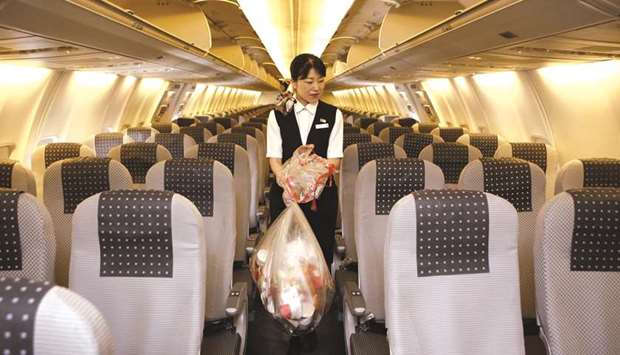Imagine you are flying an aircraft with a full seating capacity in excess of 300 passengers.
At the end of your journey, the aircraft will have accumulated nearly 430kg in cabin waste alone.
An industry research carried out at London’s Heathrow airport, one of the world’s busiest, over a period of two years highlighted the pressing need for tackling cabin waste issues, in particular the wastage from inflight meal services.
In 2018, the airline industry had generated more than 6mn tonnes of cabin waste including up to 30% untouched food and drink, according to the International Air Transport Association.
But the composition of aircraft waste varies depending on whether the flight is long- or short-haul, low-cost, full-service or charter and the cabin service provided by each airline.
Studies have also shown that within the cabin waste, there is a high component of recyclable material — newspapers and magazines in particular.
The airline industry has been always the subject of criticism for inadequate cabin waste recycling. With IATA estimating a huge growth in passenger numbers in the coming decade, the volume of cabin waste could more than double in the next 10 years!
This calls for urgent action towards proper cabin waste recycling across the global airline industry.
That said, recycling is already top on the priority of many airlines and airports around the world. And recycling clearly helps to reduce the cost of waste disposal.
A pilot study was conducted by IATA at London’s Heathrow airport in 2012 and 2013 to develop a standard cabin waste audit methodology. The study indicated that a typical passenger generates 1.43kg of cabin waste (average across both short- and long-haul international flights) of which 23% was untouched food and drink and a further 17% comprised of recyclable materials such as plastic bottles and newspapers.
All cabin waste is subject to national waste management controls that limit pollution. But data show that many countries have gone further with their regulations, introducing restrictions on catering waste from international flights to protect their agricultural sector. These regulations often demand incineration of all cabin waste with limited ability to reuse and recycle.
Some advanced countries with economically important agriculture sectors such as Australia, Canada, the European Union, New Zealand and the US have imposed strict controls on “catering waste” from international flights based on animal health concerns. These controls often preclude the reuse and recycling of any material due to the perceived risk of transferring animal disease by contaminated ingredients served in airline meals and beverages, an IATA report showed.
Industry experts say cabin waste is made up of two main streams — cleaning waste and catering (galley) waste.
Cleaning waste is leftover rubbish from items such as newspapers, paper towels, plastic bottles, food dropped on the floor, amenity kits and plastic wrapping from blankets, pillows and headsets. Cleaning waste also includes the contents of washroom bins and medical waste such as used syringes.
Catering waste is made up of inflight meals and snacks and beverages served to passengers. It consists of leftover food, drinks and packaging, which is placed back in the trolleys, in static or compactor bins.
By law, airline meals are prepared using stringent hygiene and quality control standards, originally designed for Nasa astronauts, but the regulations demand incineration of all cabin waste with limited ability to reuse and recycle, IATA has noted.
A major obstacle to airlines’ ability to reuse and recycle more cabin waste is the International Catering Waste (ICW) legislation that many governments have adopted. These regulations aim to reduce the risk of transferring animal and plant diseases by requiring ICW to be subject to special treatment.
IATA commissioned a study to understand the risks posed by airline catering waste on animal health. It advocates the adoption of smarter regulation, which allows recycling while maintaining animal health controls.
Despite all efforts and commitments made to uphold it, the industry’s waste generation continues, while tremendously increasing costs.
Cabin waste costs the industry nearly $500mn a year, according to IATA; a figure it says is rising faster than waste volumes, owing to growing disposal costs.
Perhaps this is one compelling reason why the industry leaders are exploring ways to further improve inflight waste management.
* Pratap John is Business Editor at Gulf Times.

A cabin attendant carries bags of trash in the cabin of a Japan Airlines airplane at Haneda Airport in Tokyo (file). An industry research carried out at London’s Heathrow airport over a period of two years has highlighted the pressing need for tackling cabin waste issues, in particular the wastage from inflight meal services.

